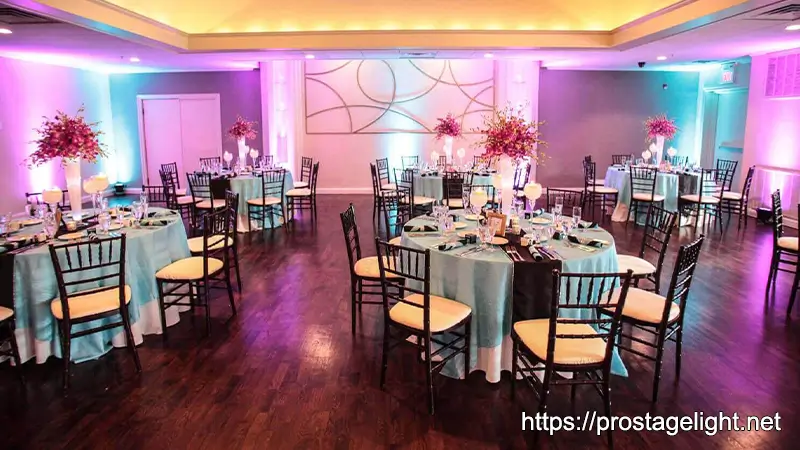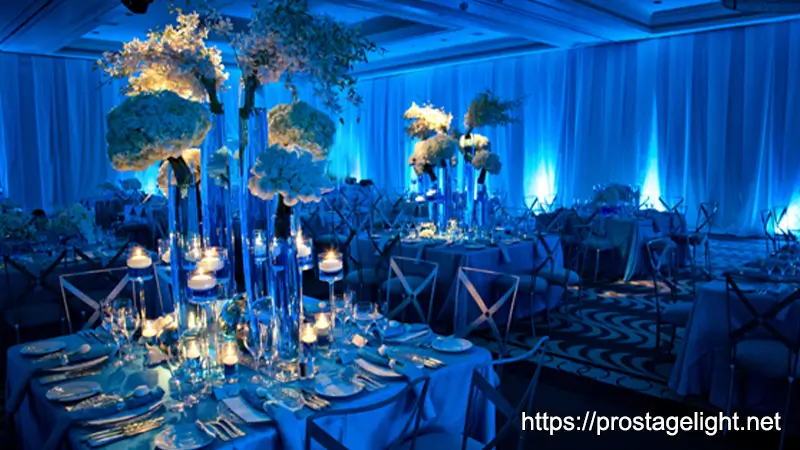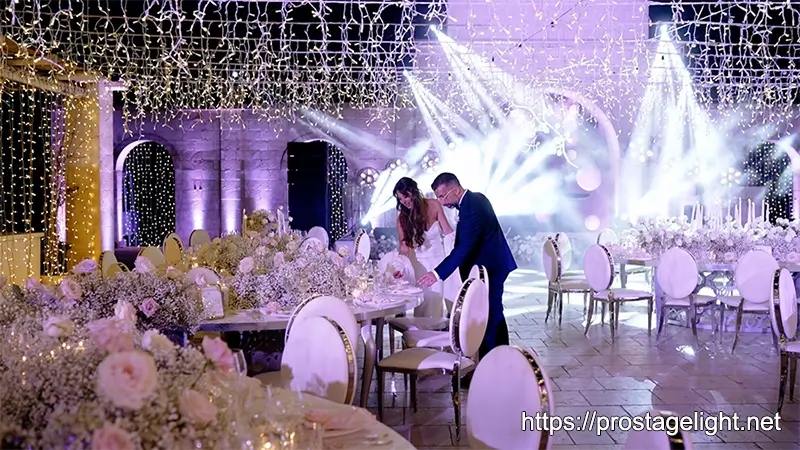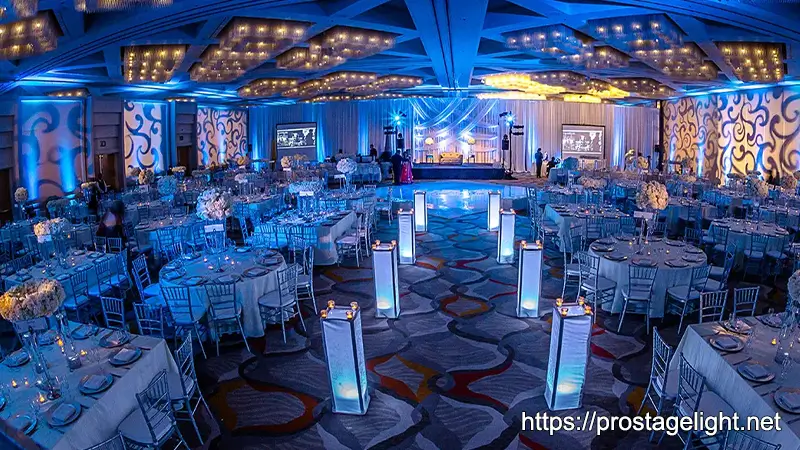The Importance of Wedding Lighting
Planning a wedding involves tremendous effort, and creating the perfect celebration requires attention to countless details. While most couples focus on venue decoration, wedding dresses, catering, and other elements, lighting is often overlooked — yet it plays a pivotal role in setting the mood for the entire event. In fact, lighting is often considered the “soul” of the wedding, creating a unique atmosphere that infuses the day with charm and magic.
Brides often dream of the moment they enter the venue: “I want to walk into my wedding with that one spotlight shining on me, feeling like the center of attention...”
Grooms, on the other hand, wish to create unforgettable memories: “I want the lighting to enhance the moment and give her the most beautiful experience...”
Wedding planners emphasize the critical role lighting plays in shaping the entire event: “Lighting helps us adapt the ambiance for different stages of the wedding, covering up imperfections and highlighting the beauty of the moment.”
The primary role of lighting is to create atmosphere. Whether it’s heightening the sense of ceremony or setting the mood during the reception, lighting enhances the emotional impact. For example, dynamic and colorful lights that pulse to the rhythm of upbeat music during the reception create an electrifying atmosphere, sparking joy and excitement among guests.
Lighting also influences emotional expression. The tone, brightness, and interplay of light can amplify the mood during each wedding moment, guiding both the couple’s emotions and the guests’ reactions.
For photos and video, the importance of lighting cannot be overstated. High-quality lighting ensures that the couple looks their best, avoiding harsh shadows or unflattering reflections. The right lighting can make each shot appear like a glamorous editorial spread, creating timeless memories for the couple to cherish.

Common Types of Wedding Lighting and Their Features
Spotlight (Follow Spot)
One of the earliest lighting effects used in weddings, the follow spot is a high-powered light that highlights the couple. As the ceremony begins and the room darkens, the spotlight comes on and follows the couple’s movements, ensuring they are the center of attention. During the bride’s entrance, for instance, the spotlight casts a brilliant beam on her, emphasizing the moment of her grand entrance. However, using only one spotlight can create an awkward “half-lit” effect, with one side of the face brightly lit while the other remains in shadow. If possible, use two spotlights from different angles to evenly illuminate the couple, ensuring a symmetrical, flattering effect.
Introduced in 2012, beam lights are known for their high intensity and striking visual impact. These lights can project beams of light that cut through the air, creating dynamic effects that change color and shape based on the wedding's needs. They are especially ideal for larger weddings where a dramatic impact is desired. When coordinated with music, the beams can pulse and shift in time with the rhythm, creating an exciting, concert-like atmosphere. Beam lights are also energy efficient, typically requiring only about 200 watts, which is an advantage when power supply is limited.
The most budget-friendly and versatile option, color wash lights (such as LED par lights) are great for creating a romantic and soft ambiance. These lights are capable of emitting various colors and can adjust brightness and flashing rates to suit the wedding theme. For example, a wedding with a purple dream theme can use wash lights to bathe the venue in a delicate purple hue, giving it an ethereal and magical quality.
Key Factors to Consider Before Designing Wedding Lighting
The Venue
Before starting the lighting design, the venue must be carefully assessed. The lighting designer should visit the site in person to measure the space and note its characteristics — including the ceiling height, wall colors, and floor materials — as well as how the venue will be decorated. This ensures that the lighting complements the overall design of the venue.
The venue itself greatly influences the type of lighting needed. Indoor venues, like hotel ballrooms, typically provide controlled lighting conditions. These spaces may have high ceilings, allowing for dramatic fixtures like chandeliers or crystal lights. In the ceremony area, spotlights, beam lights, and color wash lights can be strategically used to create the desired effect.
For outdoor venues, such as beaches or gardens, natural light is abundant, and the lighting is primarily used to enhance the atmosphere as daylight fades. String lights and LED strips are great for outlining the venue’s perimeter, and larger floodlights can illuminate the stage or dining areas. For instance, a beach wedding may incorporate blue and white string lights in trees and tents, creating a dreamy, starry-night atmosphere.
It’s also important to consider the venue’s layout. Smaller spaces may feel crowded with too many lights, while larger venues need more coverage to avoid dark corners. Columns or arches can be highlighted with lighting to blend seamlessly with the overall decor.

Wedding Theme
The lighting must align with the wedding theme to enhance the overall experience. For instance, traditional Chinese weddings, which are rich in ceremony and festivity, often feature red and gold lighting to symbolize good luck and happiness. Western weddings, on the other hand, may call for softer, purer lighting in white or pastel shades to evoke a sense of simplicity, holiness, and romance.
The lighting designer should work closely with the couple and wedding planner to choose lighting that complements the color palette, flower arrangements, and other decor elements. Lighting schemes typically include illumination for the main stage, the bride and groom's entrance, guest seating areas, and any additional outdoor areas.
Budget Considerations
Budget is a crucial factor in wedding lighting design. Balancing the ideal lighting effects with financial constraints is essential. Couples should collaborate with their wedding planner to define the lighting design early on and avoid unnecessary costs.
Collaborating with a Professional Lighting Team
Choosing the Right Lighting Designer
The lighting designer is the mastermind behind the lighting effects, so choosing the right one is critical. Experienced lighting designers can skillfully navigate the space and customize lighting based on the wedding’s atmosphere and style. Whether it’s a cozy indoor celebration or a large-scale outdoor party, a talented lighting designer can set the perfect tone for each moment.
A good lighting designer also has a strong artistic sense and can match the lighting to the couple’s vision. For example, if the theme is a fairy-tale wedding, the designer might use lighting to create an enchanting, otherworldly atmosphere. In a more minimalist wedding, they would focus on simplicity and elegance, using clean lines and subtle effects to enhance the decor.
Communication is key. The designer should maintain open dialogue with the couple, wedding planner, and other team members to ensure the lighting design aligns with the overall vision and that every element works together smoothly.

Coordination and Communication
Effective communication is the glue that holds the lighting design together. During the planning phase, the lighting designer should work with the couple and the wedding planner to align on the lighting concept and ensure it integrates with the overall wedding theme and timeline.
On the wedding day, coordination continues as the lighting designer collaborates with the DJ, photographer, videographer, and event coordinators to adjust the lighting for each part of the celebration. For example, when the couple walks down the aisle, the spotlight should perfectly track their movements, while the music and camera angles sync with the lighting to capture the moment.
Common Mistakes to Avoid
Overdoing the Lighting
One of the most common mistakes is overloading the venue with too many lighting effects. While it might seem like more lights equal more glamour, it can quickly overwhelm the venue and create a chaotic visual experience. Too many different colors or flashy effects can make it difficult for guests to focus on the important moments, like the couple’s first dance.
Ignoring Style Cohesion
Wedding lighting should be an extension of the overall theme and decor. Using a lighting design that clashes with the wedding style can create a jarring effect. For example, a modern, minimalist wedding with neutral tones would not suit ornate, colorful lighting that might be better suited for a traditional or opulent event.
To avoid overcomplicating things, it’s best to adhere to the principle of “less is more.” Focus on a few key lighting elements that can emphasize the couple’s special moments and create a cohesive, beautiful atmosphere throughout the venue. Professional designers can guide the couple in selecting the right lighting to suit both their vision and the venue’s limitations.

Frequently Asked Questions
1. Why is wedding lighting so important?
Wedding lighting creates atmosphere, enhances emotional moments, and ensures beautiful photos and videos. It can transform a venue and highlight key moments like the couple's entrance or first dance.
2. What are the most common types of wedding lighting?
The most common types are spotlight (follow spot), beam lights, and color wash lights. Each serves a unique purpose, from highlighting the couple to creating a dramatic atmosphere with vibrant colors.
3. How do I choose the right lighting for my wedding venue?
Consider the venue’s size, layout, and lighting conditions. Indoor venues may require spotlights or chandeliers, while outdoor venues benefit from string lights and floodlights to create a magical ambiance.
4. Can lighting design match my wedding theme?
Yes! Lighting should complement your wedding theme. For a traditional wedding, warm red and gold lighting works well, while a more modern or romantic theme may call for softer, pastel-colored lights.
5. What mistakes should I avoid when planning wedding lighting?
Avoid overloading the space with too many lights, which can create a chaotic feel. Also, ensure the lighting complements your wedding style and doesn’t clash with the overall decor.
